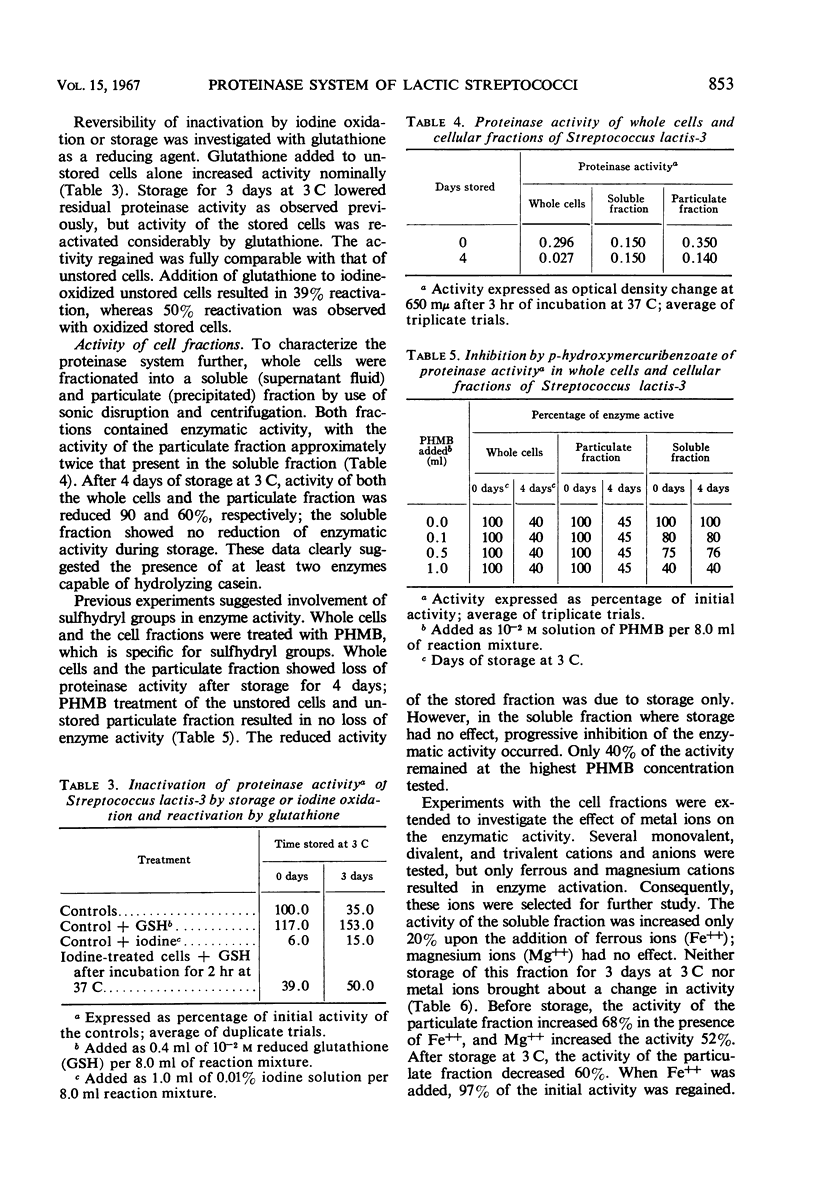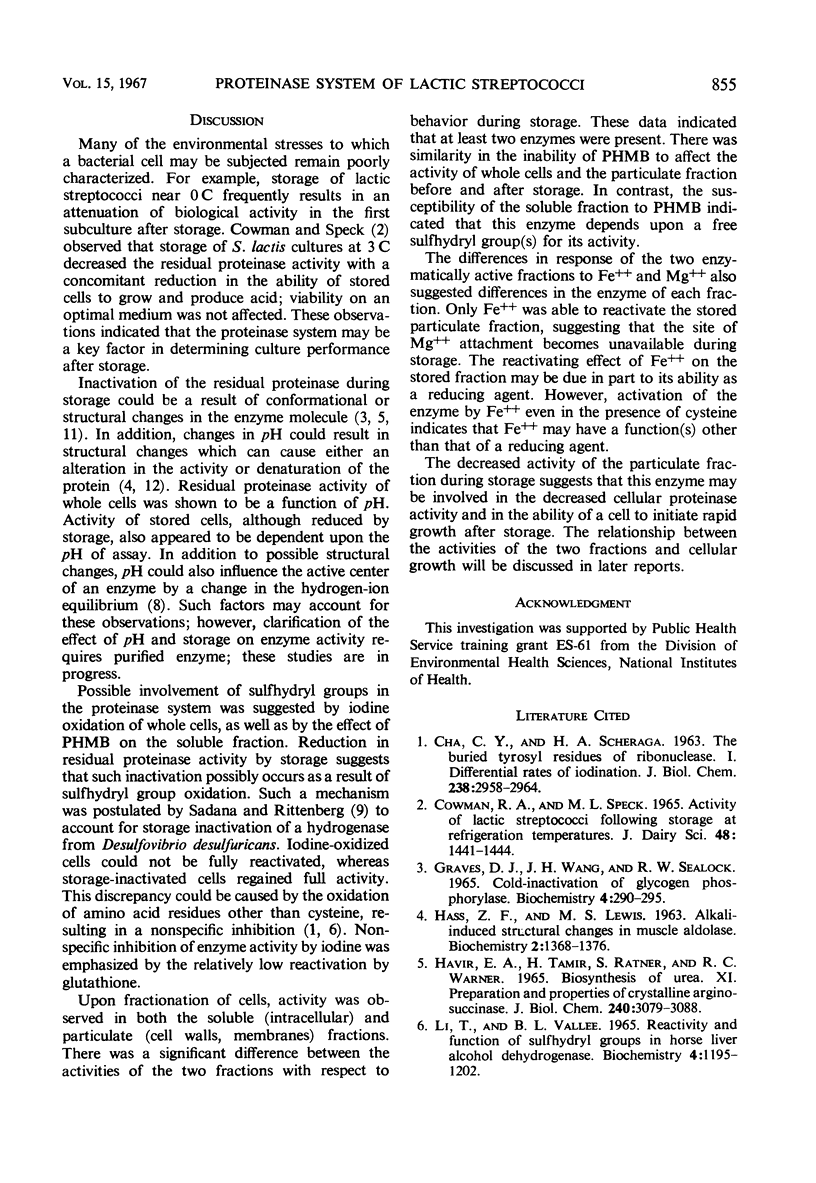Abstract
Proteinase activity of Streptococcus lactis cells was maximal at pH 6.0, but after storage at 3 C the minimal activity was observed at this pH. Activity lost as a result of storage could be restored by adding glutathione. Whole cells were fractionated into soluble (intracellular) and particulate fractions by sonic disruption; both fractions contained enzymatic activity. Activity of the soluble (intracellular) fraction was found to be stable to storage at 3 C, but was inhibited progressively with increasing concentrations of p-hydroxymercuribenzoate (PHMB). The enzymatic activity of this fraction was not activated by ferrous or magnesium ions or by cysteine. In contrast, activity of the particulate fraction was labile to storage at 3 C, and the reduction was comparable to that of stored cells. Furthermore, proteinase activity in the cells and the particulate fraction was not affected by addition of PHMB. The particulate fraction was activated by ferrous and magnesium ions and by cysteine. After storage, only ferrous ion and cysteine promoted reactivation; magnesium ion was totally ineffective. The enzyme(s) contained in the particulate fraction may be involved in decreased proteinase activity observed in whole cells and in the effect on growth of cells after storage.
Full text
PDF





Selected References
These references are in PubMed. This may not be the complete list of references from this article.
- CHA C. Y., SCHERAGA H. A. THE BURIED TYROSYL RESIDUES OF RIBONUCLEASE. I. DIFFERENTIAL RATES OF IODINATION. J Biol Chem. 1963 Sep;238:2958–2964. [PubMed] [Google Scholar]
- Cowman R. A., Speck M. L. Activity of lactic streptococci following storage at refrigeration temperatures. J Dairy Sci. 1965 Nov;48(11):1441–1444. doi: 10.3168/jds.S0022-0302(65)88495-8. [DOI] [PubMed] [Google Scholar]
- HASS L. F., LEWIS M. S. ALKALI-INDUCED STRUCTURAL CHANGES IN MUSCLE ALDOLASE. Biochemistry. 1963 Nov-Dec;2:1368–1376. doi: 10.1021/bi00906a032. [DOI] [PubMed] [Google Scholar]
- HAVIR E. A., TAMIR H., RATNER S., WARNER R. C. BIOSYNTHESIS OF UREA. XI. PREPARATION AND PROPERTIES OF CRYSTALLINE ARGININOSUCCINASE. J Biol Chem. 1965 Jul;240:3079–3088. [PubMed] [Google Scholar]
- Li T. K., Vallee B. L. Reactivity and function of sulfhydryl groups in horse liver alcohol dehydrogenase. Biochemistry. 1965 Jun;4(6):1195–1202. doi: 10.1021/bi00882a031. [DOI] [PubMed] [Google Scholar]
- MUKATIS W. A., NIEMANN C. VARIATION OF THE CONFORMATION OF THE ACTIVE SITE OF ALPHA-CHYMOTRYPSIN WITH HYDROGEN ION CONCENTRATION. II. Proc Natl Acad Sci U S A. 1964 Mar;51:397–402. doi: 10.1073/pnas.51.3.397. [DOI] [PMC free article] [PubMed] [Google Scholar]
- SADANA J. C., RITTENBERG D. IRON REQUIREMENT FOR THE HYDROGENASE OF DESULFOVIBRIO DESULFURICANS. Arch Biochem Biophys. 1964 Nov;108:255–257. doi: 10.1016/0003-9861(64)90384-4. [DOI] [PubMed] [Google Scholar]
- SHUSTER C. W., DOUDOROFF M. A cold-sensitive D(-) beta-hydroxybutyric acid dehydrogenase from Rhodospirillum rubrum. J Biol Chem. 1962 Feb;237:603–607. [PubMed] [Google Scholar]
- Sherman J. M., Naylor H. B. Ageing without Reproduction and the Viability of Young Bacterial Cells at Low Temperatures. J Bacteriol. 1942 Jun;43(6):749–756. doi: 10.1128/jb.43.6.749-756.1942. [DOI] [PMC free article] [PubMed] [Google Scholar]
- WANG J. H., GRAVES D. J. THE RELATIONSHIP OF THE DISSOCIATION TO THE CATALYTIC ACTIVITY OF GLYCOGEN PHOSPHORYLASE A. Biochemistry. 1964 Oct;3:1437–1445. doi: 10.1021/bi00898a008. [DOI] [PubMed] [Google Scholar]


